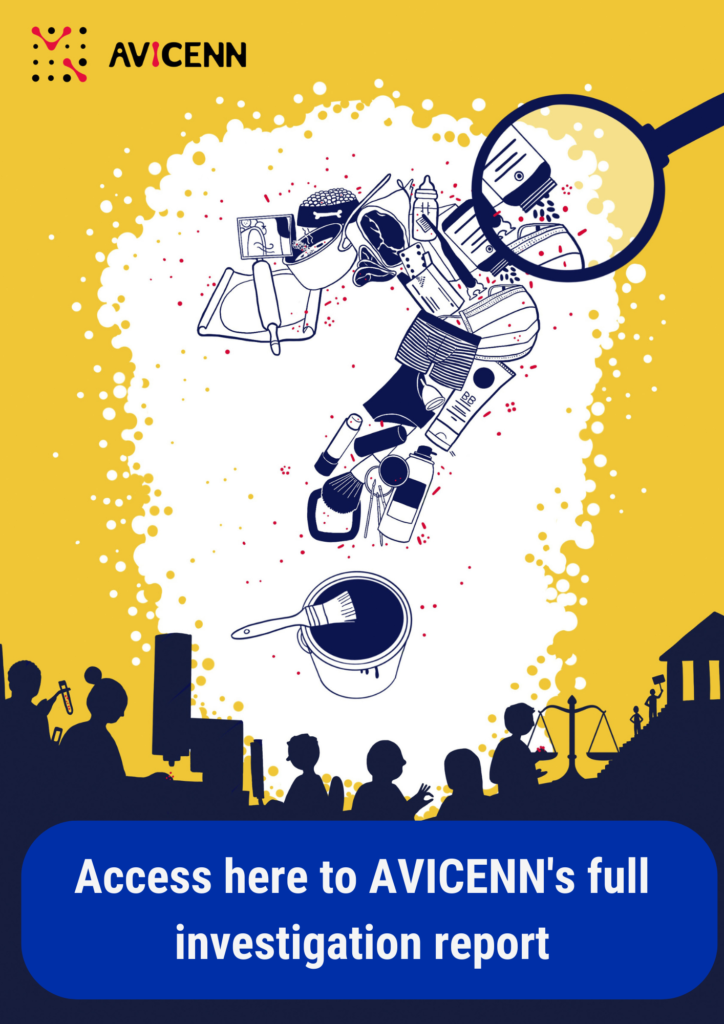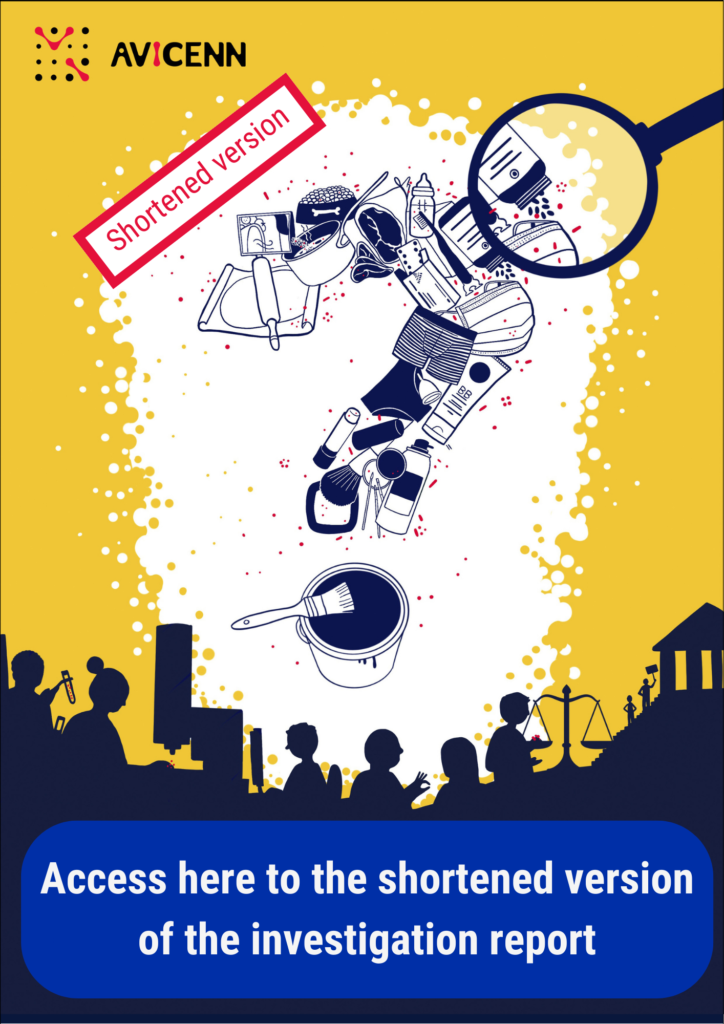
Our product tests

Our product tests
By the AVICENN team – Last modification October 2025
Context and objectives
In the first half of 2021, IKEA withdrew from the market its new GUNRID “air purifier curtains”: our tests had shown the massive presence of nanoparticles of titanium dioxide (suspected carcinogens for humans) on the surface of the fibers … and a lack of depolluting efficiency.
In September 2021, we decided to launch tests on about twenty everyday consumer products, with the primary objective of ascertaining the presence (or not) of nanoparticles of concern in everyday products.
Our approach was in line with the aim to make a concrete contribution to the 4th National Environmental Health Plan (PNSE 4) published in 2021, where action 13 aims in particular to:
- improve knowledge on the use of nanomaterials
- control and extend the labeling requirements for nanomaterials in everyday objects.
Our approach
Our investigation took place over 15 months:
- Between September and October 2021, we defined the criteria for product selection: products likely to contain nanoparticles with well-documented hazards, cause frequent/chronic exposure, be sold on a large scale, affect various populations, etc.
- We then targeted specific products:
- by soliciting our members and subscribers,
- by carrying out documentary reviews (veillenanos.fr, the NanoDatabase, online sales sites > labeling, technical data sheets, SDS)
- By scouting in supermarkets
- By asking public authorities, research laboratories and brands
- At the end of 2021 / beginning of 2022, we sent about 20 products to the National Laboratory of Metrology and Testing (LNE).
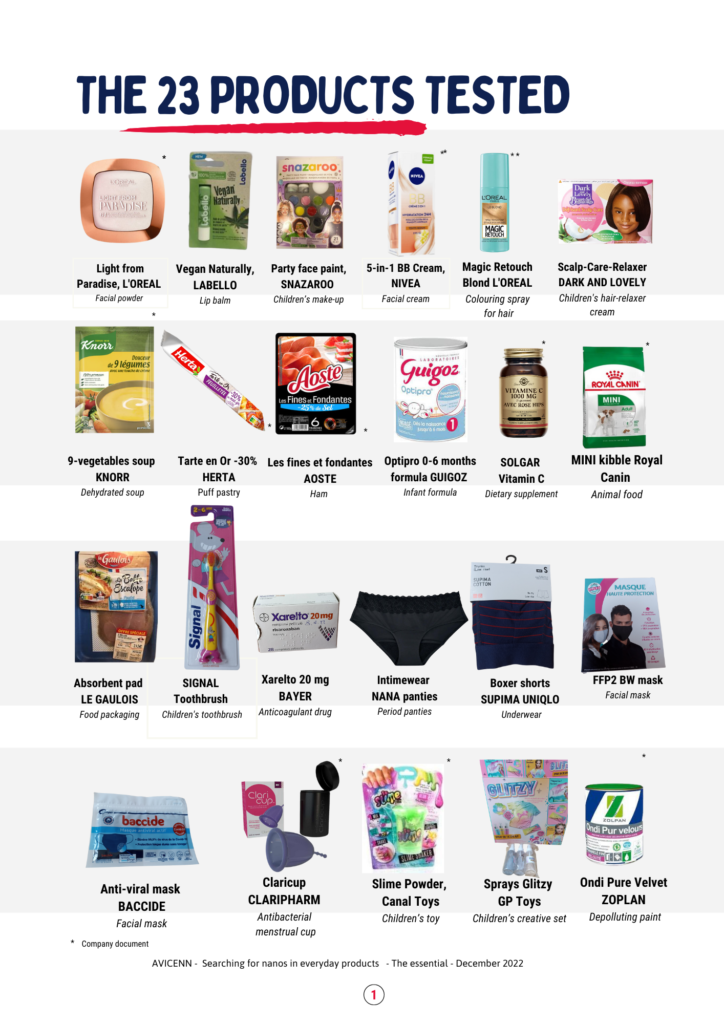
- The tests were carried out between the end of 2021 and the end of August 2022 at LNE, with the final analysis report received mid-October 2022.
- AVICENN published its report “In search of [nanos] in everyday products” on December 15, 2022. The tests reveal the presence of unlabeled, sometimes even unauthorized, nanos in 20 of the 23 everyday products tested:
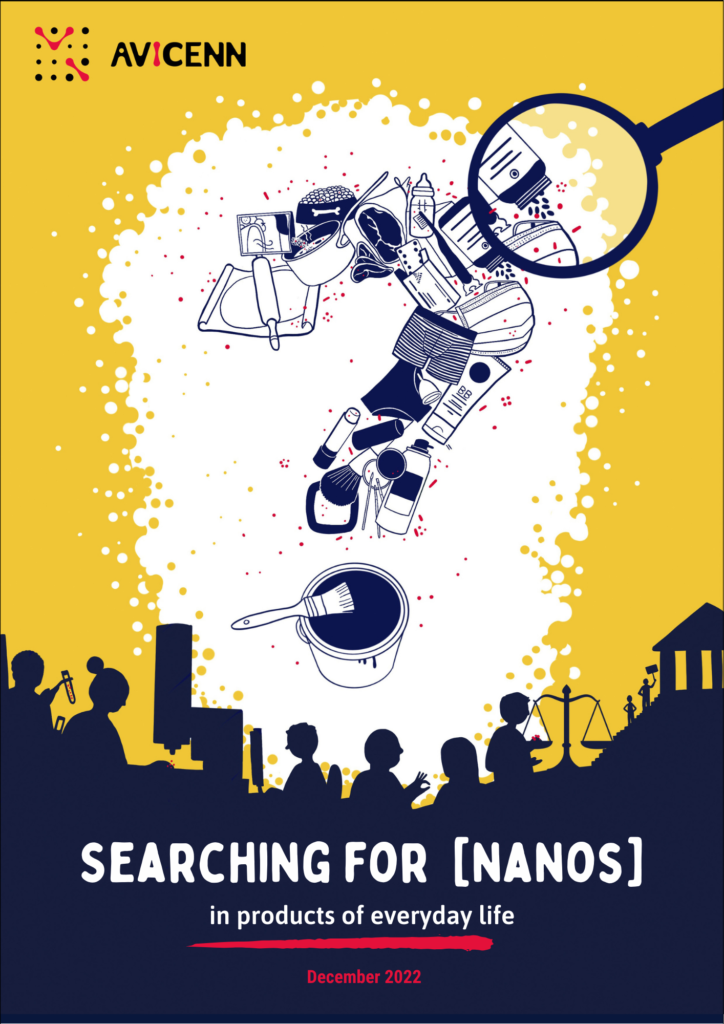
The results: nanos found in 20 products out of 23
Nanos have been detected in 20 products.
Results by product category
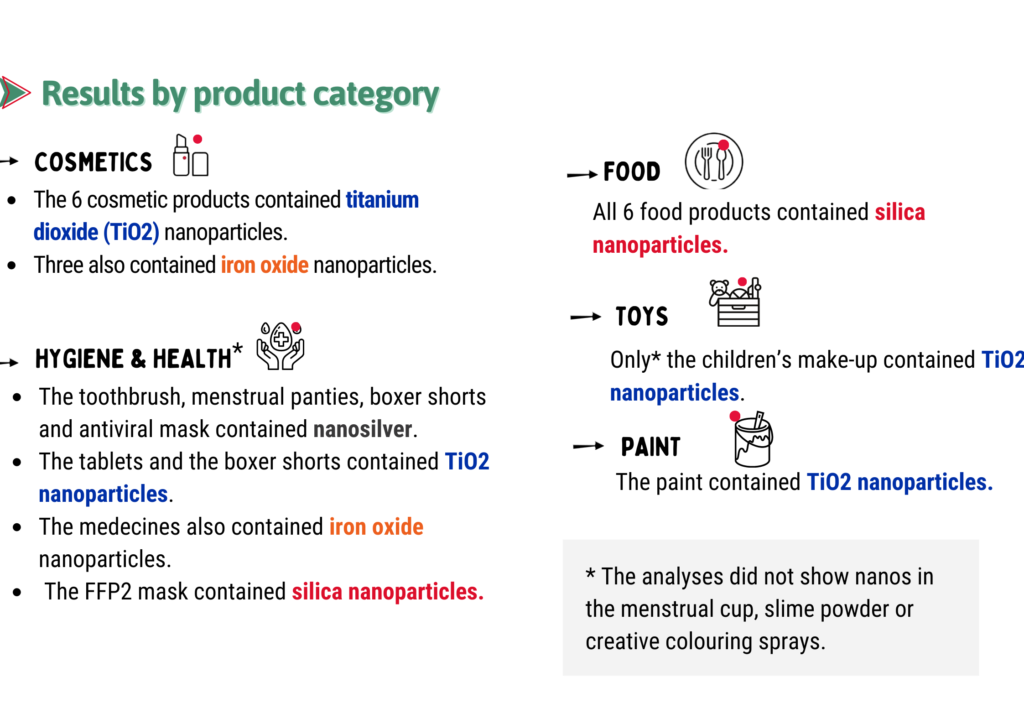
Results by type of nanoparticles
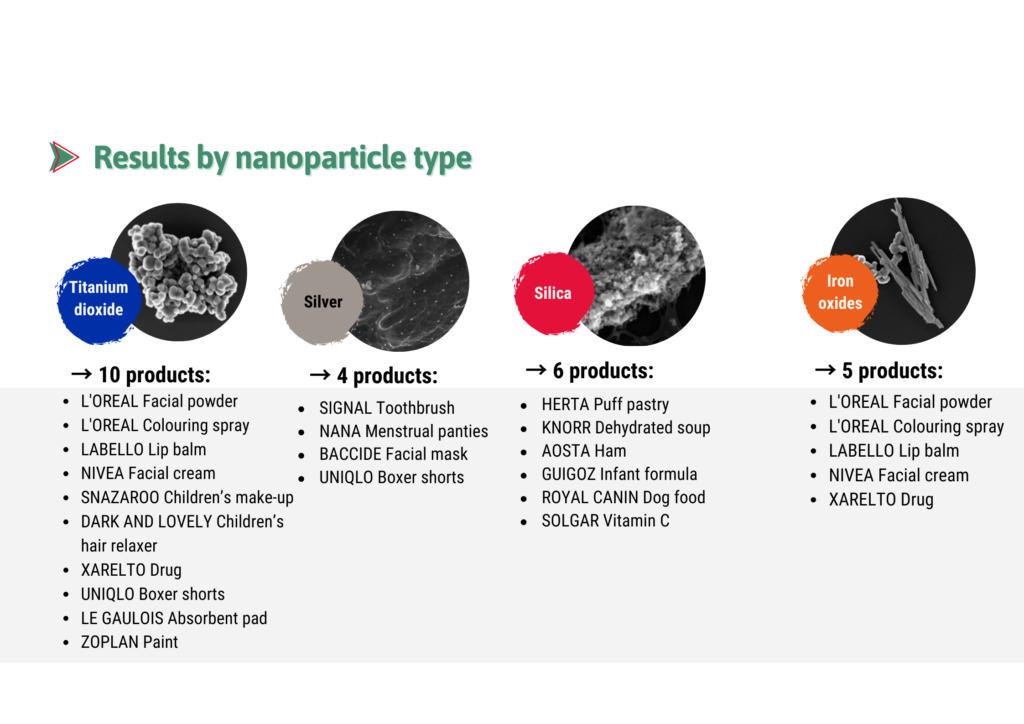
Key findings
More nanos than expected and some new questions…
We selected products that, although not labeled “nano”, were more likely than others to contain nanos. And yet we were surprised by the high proportion of products containing nanos as well as discovering some where we did not expect them.
These results raise questions about the extent of the use of nanos in everyday products and show the relevance – and even the necessity – of using the new tools available and innovative approached to look for nanos in commonly used items.
Assessment of the [nano] labeling: a complete failure!
The results show how eminently flawed the [nano] labeling is.
None of the products in which we have detected nanos were labeled [nano] even though most of them are covered by the European obligation of “nano” labeling, which has been in force for almost ten years for cosmetics, food products and biocides.
The presence of nanos in other product categories also underlines the need to extend the [nano] labeling obligation to product categories that are unfortunately still not currently concerned.
Many unauthorized nanos
Our tests have also highlighted, to an unsuspected extent, the fact that nanos are commonly used even though they are not authorized. This is particularly the case in cosmetics and hygiene and health products.
Summary of AVICENN’s requests
Because of the health and environmental risks associated with nanomaterials, AVICENN makes three requests at the end of the report:
1 – to improve knowledge and awareness of marketed nanomaterials, in particular by improving the French register (ten years after its creation, this register remains a real sieve) and the implementation of a European register of products containing nanos and to better evaluate their risks, by making the companies that import, produce or use them contribute to the analyses;
2 – increase transparency on these nanomaterials with, among other things, the intensification of controls and sanctions in case of non-compliance with legal obligations (whether it be labelling, registration, and/or authorization);
3 – and finally, increase vigilance with the introduction of a generalized obligation for an assessment of the benefit/risk ratio and collective utility of nanomaterials BEFORE they are put on the market and with the implementation of specific measures concerning nanos that escape the new European recommendation for the definition of the term “nanomaterial“. The announced transposition of the nanomaterial term into the regulations governing cosmetics and “novel foods” being under review, the risk is indeed great that many nanos could go off the radar of public authorities.
They talk about our investigation
In the media
- European and international press: Chemical Watch, RFI, BBN World News, Food Navigator, California 18, Il Salvagente, Il Ssusidario, Psychomédia, RTBF, the NanoDataBase, …
- French national media : France inter (7 a.m. news on December 15), France info web, radio and TV, Le Monde, What to choose, 60 millions de consommateurs, Liberation, The Tribune, 20 Minutes, Le Figaro, Les Echos, La Croix, The Express, BFM, Ecoréseau, Syndicalisme Hebdo, Novethic, Reporterre, GEO, Planet, HelloDoctors, Santé Magazine, I’m interested, Medisite, Why Doctor, Femina, Femme actuelle, Madame Figaro, Marie-Claire, …
- French regional media : France Bleu, Ouest France, Nice Matin, Var Matin, La Dépêche, …
At the National Assembly
Following our tests, four written questions were put to the government:
- On December 27, 2022, in his question n°4492 written to the attention of the Minister of Health, the Renaissance deputy Guillaume Vuilletet invoked “the need to systematize the research and for a ban of nanoparticles in everyday products”. The MP believes that “the medium- and long-term health risks seem to be largely underestimated, especially in the case of chronic exposure to products containing several nanoparticles in large quantities, such as certain cosmetic products. Mr. Vuilletet further emphasized that “The precautionary principle is essential: consumer exposure to nanomaterials must be clearly limited until their safety has been demonstrated. He asked the Minister about his willingness to“intensify controls and sanctions for companies that do not comply with the labeling obligation and the relevance of implementing the recommendation of AVICENN, which proposes that manufacturers participate in the financing of independent research to better assess the risks associated with nanomaterials”.
- Three other questions were subsequently asked by other members:
- On January 31, 2023, in his written question n°5046, Renaissance Deputy Karl Olive has called for an assessment of “the current regulations and possible evolutions”.as well as “the means implemented by the Ministry and the Directorate of Consumer Affairs and Fraud Control to better control the use of these particles and in particular titanium dioxide” and the “means of informing the consumer about these nanoparticles via labelling in particular”.
- On February 14, 2023, in her written question No. 5449, the deputy Horizons Agnes Carel also asked to know “what provisions are planned to better control the use of these particles and in particular titanium dioxide and better inform the consumer of their presence in the products they consume.
- On February 21, 2023, in his written question n°5701, Renaissance MP Vincent Ledoux asked the government to “please tell him what he intends to implement in order to better control the presence of these nanoparticles in everyday products, which constitute a worrying public health problem”.
Since the publication of our tests
Over the months, several of the tested products or identified nanoparticles have been removed from store shelves:
- IKEA has withdrawn its GUNRID curtains, which contained titanium dioxide nanoparticles.
- Aoste now offers nitrate-free ham, which is also free of silica nanoparticles.
- Nana has launched a new cotton underwear, which the company assured us is free of nanosilver (and silver).
- Signal has removed silver nanoparticles from its toothbrushes (and titanium dioxide from its toothpastes).
- Guigoz certifies that its powdered milk and other products no longer contain silica nanoparticles.
- The “Light from Paradise” powder by L’Oréal is no longer available for purchase on L’Oréal’s website and has disappeared from store displays and websites of several retailers where it was previously sold.
The report is available in both English and French
The English version of our report was released at the conference organized by the European NGO ECOS on February 15, 2023, entitled ” Unnoticed and ungoverned: How nanomaterials are slipping through the cracks ” (and relayed by One Policy Place – OPP).
Any questions or comments? This information sheet compiled by AVICENN is intended to be completed and updated. Please feel free to contribute.
The latest news
Our information sheets to go further
Upcoming Nano Agenda
- Spectacle Art & Science – When science changes as it passes from mouth to mouth
- A unique participatory experience centered on the human factory of knowledge, where two fascinating worlds meet: nanomedicine, with its nanoparticles and cellular nanovectors, and quantum physics, with its superimposed states and complex systems.
- Organizers: Centre National de Compétences en Nanosciences (C’Nano), in collaboration with the Commissariat à l’Énergie Atomique (CEA), the Institut Polytechnique de Paris (IPP) and the Centre National de la Recherche Scientifique (CNRS).
- Speakers: Florence Gazeau, academician, physicist, research director at CNRS, and Charles Antoine, PhD in physics, lecturer at Sorbonne University, and Albert Moukheiber, PhD in neuroscience.
- Location: Théâtre de la Ville
- Website: https: //www.theatredelaville-paris.com/…/rencontres/nano-rumeurs…
- 8th Congress of Occupational Medicine and Health (CNMST 2026)
- Theme 5: Emerging pathologies and risks, Mr Henri Bastos (ANSES), Pr Lynda Bensefa-Colas (AP-HP), Dr Catherine Nisse (CHU Lille)
- Website: www.medecine-sante-travail.com
- 20th meeting of the “nano and health” dialogue committee
- Organizer: ANSES
File originally created in January 2022

